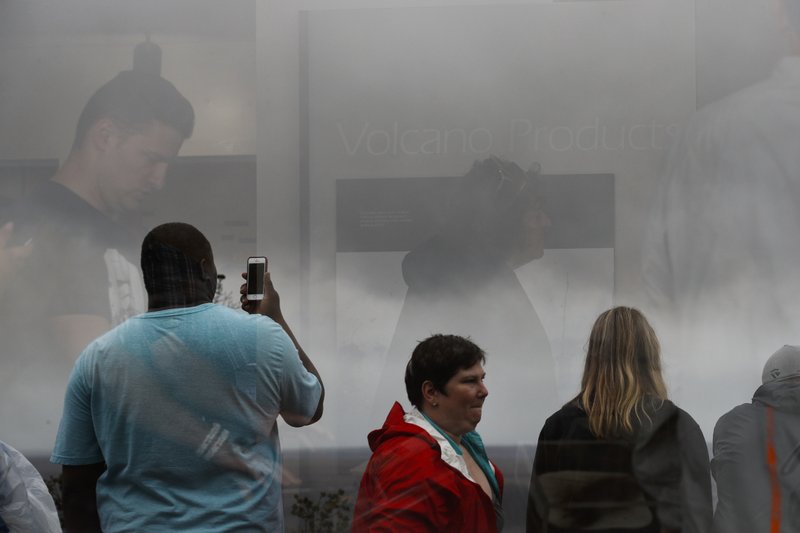VOLCANO, Hawaii -- Warnings that Hawaii's Kilauea volcano could shoot boulders and ash out of its summit crater are prompting people to rethink their plans to visit the Big Island.
But most of the rest of the island is free of volcanic hazards, and local tourism officials are hoping travelers will recognize the Big Island is ready to welcome them.
Rachel Smigelski-Theiss is among those who have shifted gears. She had intended to visit Kilauea's summit with her husband and 5-year-old daughter and stay in Volcano, a town a few miles from the crater. Now they've cancelled their trip. She said she's worried potential flight disruptions would strand them on the island.
"My equivalent of this -- and I'm from South Florida where we have hurricanes -- is driving quite literally into a hurricane," she said.
Hawaii officials have had a busy month pleading with travelers to keep their plans even as dramatic images of natural disasters afflicting the islands have bombarded televisions and social media feeds.
In April, floods on Kauai Island made travelers nervous. Then last week, it was Kilauea volcano sending 2,200-degree lava bursting through cracks into people's backyards in the Leilani Estates neighborhood. Then as Kilauea's magma shifted underground, a magnitude-6.9 earthquake rocked the Big Island.
Since the quake, there have been frequent aftershocks. More than a dozen fissures oozing lava have opened in the ground. Adding to the distress, of the 36 structures destroyed, 26 were homes.
And now, scientists are warning that an explosive eruption may occur at the summit crater within weeks.
Tina Neal, the scientist-in-charge of the U.S. Geological Survey's Hawaiian Volcanoes Observatory, said geologists don't expect the summit eruption to be life-threatening so long as people stay out of the national park. Volcano and other nearby communities may be showered by pea-sized fragments or dusted with nontoxic ash but they aren't expected to get hit by large boulders, she said.
Robert Hughes, the owner of Aloha Junction Bed and Breakfast in Volcano, said he's had "tons" of cancellations since Wednesday, when geologists first warned of the explosive eruption.
But Hughes, a 45-year resident of the village of some 2,500 people, suspects he'll soon hear from adventurers and photographers who want to see the eruption up close.
"I'm not too worried about it because I've lived here so long and I've seen it go through lots of different episodes," Hughes said.
The town, which is nestled in a lush rain forest a few miles from the crater, is a popular overnight spot for park visitors.
Hawaii Volcanoes National Park's decision to close Friday because of the risk of an explosive eruption will discourage travelers, said Janet Coney, the office manager at Kilauea Lodge, an inn in Volcano. The lodge, which has 12 rooms and four cottages, has had a handful of cancellations. Coney is anticipating more depending on what happens.
The CEO of the Hawaii Tourism Authority, the agency that markets Hawaii to the world, said Kilauea is being monitored around the clock to provide the public with the best information. But George Szigeti noted that the Big Island is "immense" and there are large parts of the island unaffected by the volcano.
The unaffected areas include the town of Kamuela, which is home to vast cattle ranches and Hawaii's own cowboys, called paniolo, and the coffee farms on the Kona side of the island, which is more than 100 miles away from where lava is erupting. There's also the night sky visible from the 13,803-foot summit of Mauna Kea, the island's tallest peak and the location of some of the world's most advanced telescopes.
Ross Birch, the executive director of the Island of Hawaii Visitors Bureau, said officials "walk the fine line."
"We know what people are going through in Leilani Estates. And we don't want to seem callous and inconsiderate in our messaging and our promotion of the island," he said. At the same time, tourism is the island's biggest industry and people's livelihoods are dependent on visitors coming, he said.
"We want to make sure that everybody is still working and people have jobs to go back to," Birch said.
Information for this article was contributed by Jennifer Sinco Kelleher of The Associated Press.
A Section on 05/12/2018
